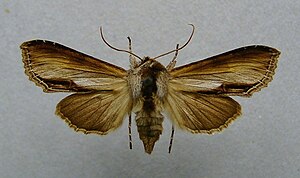Figwort forest monk
| Figwort forest monk | ||||||||||||
|---|---|---|---|---|---|---|---|---|---|---|---|---|

Figwort forest monk ( Shargacucullia prenanthis ) |
||||||||||||
| Systematics | ||||||||||||
|
||||||||||||
| Scientific name | ||||||||||||
| Shargacucullia prenanthis | ||||||||||||
| ( Boisduval , 1840) |
The figwort forest monk ( Shargacucullia prenanthis ), also called the golden-brown woolly herb monk , is a butterfly ( moth ) from the owl butterfly family (Noctuidae).
features
butterfly
With a wingspan of 37 to 43 millimeters, the moths belong to the medium-sized monk owl species. The forewings are of an ocher-brown basic color. The inner edge area is dark brown and extends significantly in the form of a step towards the hem. Around the middle of this area is a single, bright, crescent-shaped sign. A whitish field can be seen in the middle above the inner edge. The hem is slightly jagged. Cross lines and blemishes are not visible. The front edge is broad, dark brown to reddish brown in color and gradually turns into lighter tones inward. The hind wings without drawing are brownish in color. The hood typical of monk owls can be seen on the head and neck, which is formed from hair that is strongly directed forward. There are other, shorter heads of hair on the abdomen.
egg
The egg is spherical, but strongly flattened and ribbed at the base. It is chalky white in color.
Caterpillar
Adult caterpillars are green in color, from which narrow yellowish or whitish dorsal, secondary and lateral lines stand out. They do not show the bright and bright warning color pattern that characterizes many other monk owl caterpillars and appear rather inconspicuous.
Doll
The doll is colored ocher yellow. The shovel-shaped, hollowed-out Kremaster is particularly striking .
Similar species
Some similar species from the large number of "brown monks" are selected below:
- Aster monk ( Cucullia asteris )
- Brownwort monk ( Shargacucullia caninae )
- Shargacucullia gozmanyi
- Gray cabbage monk ( Shargacucullia lychnitis )
- Mullein Monk ( Shargacucullia verbasci )
- Figwort monk ( Shargacucullia scrophulariae )
- Shargacucullia scrophulariphaga
- Shargacucullia scrophulariphila
- Lost mullein monk ( Shargacucullia thapsiphaga )
Prenanthis differs from the aforementioned species in the following features of its forewings:
- the slightly wider and shorter form
- the only slightly wavy outer edge
- the white field above the inner edge
- the single and slightly curved crescent spot
- the distinctive step on the dark boundary line of the inner edge
A genital morphological examination can also be used to confirm this.
Occurrence and habitat
The species is widespread from south-east France across the Alpine region with the adjoining low mountain ranges and further east to Romania and Bulgaria . It is also found in Asia Minor and Lebanon . It is absent in the lowlands because it is a typical inhabitant of the mountain and hill country. S. prenanthis has an allopatric sister species Shargacucullia armena , which is native to Turkey and Armenia . The figwort forest monk can mainly be found in damp deciduous, mixed and coniferous forests, provided that there are abundant stocks of gnarled figwort ( Scrophularia nodosa ). It can also sometimes be found in places outside of forests when the forage plant is growing there.
Way of life
The species forms one generation a year, with the main flight time of the nocturnal moths from April to June. They sometimes appear on artificial light sources . The females prefer to lay the eggs on the underside of not fully bloomed flower buds. The caterpillars feed on various species of figwort ( Scrophularia ), especially gnarled figwort ( Scrophularia nodosa ) from June to August . They pupate in a solid cocoon on the ground in autumn , with the pupae occasionally lying two years above the ground.
Danger
The figwort forest monk has been proven in the German federal states of Bavaria , Baden-Württemberg , Rhineland-Palatinate and Hesse and is included on the red list of endangered species on the warning list.
swell
Individual evidence
- ↑ a b Gábor Ronkay & László Ronkay: Cucullinae I . In: Michael Fibiger, Martin R. Honey, W. Gerald Tremevan (Eds.): Noctuidae Europaeae . tape 6 . Entomological Press, Sorø 1994, ISBN 87-89430-03-4 (English).
- ^ A b Walter Forster , Theodor A. Wohlfahrt : The butterflies of Central Europe. Volume 4: Owls. (Noctuidae). Franckh'sche Verlagshandlung, Stuttgart 1971, ISBN 3-440-03752-5 .
- ↑ a b Günter Ebert (Ed.): The butterflies of Baden-Württemberg . 1st edition. tape 6 . Moth IV. Noctuidae 2nd part. Ulmer, Stuttgart (Hohenheim) 1997, ISBN 3-8001-3482-9 .
- ↑ Federal Agency for Nature Conservation (Ed.): Red List of Endangered Animals in Germany . Landwirtschaftsverlag, Münster 1998, ISBN 3-89624-110-9 .
literature
- Günter Ebert (Ed.): The butterflies of Baden-Württemberg . 1st edition. tape 6 . Moth IV. Noctuidae 2nd part. Ulmer, Stuttgart (Hohenheim) 1997, ISBN 3-8001-3482-9 .
- Gábor Ronkay & László Ronkay: Cucullinae I . In: Michael Fibiger, Martin R. Honey, W. Gerald Tremevan (Eds.): Noctuidae Europaeae . tape 6 . Entomological Press, Sorø 1994, ISBN 87-89430-03-4 (English).
Web links
- Lepiforum e. V. Taxonomy and Photos
- www.nic.funet.fi dissemination
- www.schmetterlinge-deutschlands.de Endangerment
- Cucullia prenanthis at Fauna Europaea. Retrieved February 24, 2011